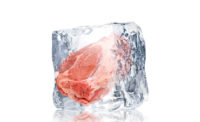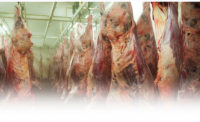Tech | Meat Science
Spray chilling beef sides can hasten temperature decline during postmortem chilling

By Lydia M. Hite, Amanda D. Blair, Keith R. Underwood, Judson K. Grubbs, Department of Animal Science, South Dakota State University, Brookings, S.D.
Depending on the species, processing facilities implement chilling methods that include air or spray chilling of carcasses.
Air chilling involves the movement of air around the carcasses, averaging about 39° F.
Spray chilling includes similar air movement throughout the cooler with the addition of a cooled water being sprayed over the carcass during the chilling cycle. The use of spray chilling historically has been to improve yields by reducing moisture loss that occurs during chilling.
In 1991, the first National Beef Quality Audit was conducted to provide baseline data for the beef industry and has been done approximately every five years since. Beef hot-carcass weights have increased from an average of 760 pounds in 1991 to an average of 859 pounds in 2019. So, the chilling systems initially built in the 1980s were designed to chill carcasses 100 pounds lighter than the average beef hot-carcass weight of today. Heavier beef carcasses may require a longer chilling period because of biochemical heat generation in the carcass. Inadequately chilling a beef carcass can result in food safety and beef quality issues that will negatively impact consumers’ eating experience.
Evidence also suggests that spray chilling decreases the temperature in carcasses more quickly than air chilling. The majority of small processors and university meat laboratories use air chilling systems to chill carcasses. To better understand spray-chilling systems utilized by large processing facilities, the objective of this study was to evaluate the effect of a chilling system on the temperature decline in the chuck, loin and round of beef carcasses. Ten cattle were slaughtered, and sides of the carcass were assigned to one of two chilling system treatments: air chilling (AIR) or spray chilling (SPRY). The AIR treatment consisted of sides being chilled by air movement only. The air temperature of the chilling cooler was on average 38° F with air movement about 4,500 yards per minute. The SPRY treatment included similar air movement within the cooler with the addition of a timed spraying of cooled water at 39° F. Water was sprayed over the beef sides for 80 seconds and repeated every 32 minutes for 24 hours at 60 – 65 psi. Prior to entering the chilling cooler, temperature data loggers were placed into the chuck, loin and round of each carcass at different depths and temperature was recorded every 30 minutes for 24 hours. In the chuck, data loggers were placed at 4, 6 and 8 inches deep into the serratus ventralis. Data loggers were placed 2, 4, 6 and 8 inches deep into the semimembranosus of the round. Due to a smaller size of the loin primal compared to the chuck or round, only one logger was placed, 4 inches deep, into the longissimus lumborum.
The beef sides exposed to the SPRY treatment were cooler than AIR-chilled sides in the round, loin and chuck. In the chuck, the sides exposed to the SPRY treatment had lower temperatures recorded by the loggers placed at 4 and 6 inches deep compared with the AIR sides. At time 0, when the beef sides were entering the chilling cooler, the 2-inch-deep data logger in the round recorded an average temperature of 86° F. The average of 86° F for the 2-inch-deep data logger in the round was lower in temperature compared to the 4-, 6- and 8-inches-deep data loggers that had temperatures of 102, 104 and 102° F respectively at time 0. At 24 hours into the chilling period, as depth increased in the round, temperature also increased as temperatures recorded by each data logger differed.
Tissues located closer to the surface reached lower temperatures and chilled faster than deep tissue in both the AIR and SPRY treatments. Internal temperature decline differed between depths for AIR and SPRY treatments in all primals. The use of spray-chilling systems on beef sides allowed for more rapid chilling compared with air-chilled sides. The air-chilled sides had higher temperatures than the spray-chilled sides at all depths. Higher temperatures in beef sides can result in increased protein denaturation postmortem. Protein denaturation can result in product quality issues through poor color and decrease in tenderness formation. The use of a spray-chilling system on beef sides can decrease protein denaturation and increase tenderness development postmortem. NP
Looking for a reprint of this article?
From high-res PDFs to custom plaques, order your copy today!








